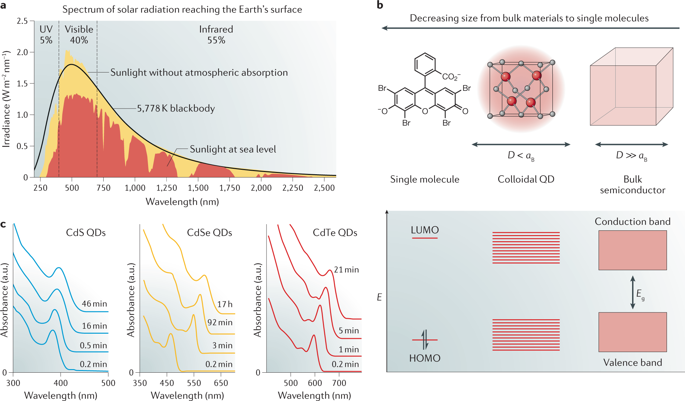Nature Reviews Chemistry ( IF 38.1 ) Pub Date : 2018-07-27 , DOI: 10.1038/s41570-018-0024-8 Xu-Bing Li , Chen-Ho Tung , Li-Zhu Wu

|
Sunlight is our most abundant, clean and inexhaustible energy source. However, its diffuse and intermittent nature makes it difficult to use directly, suggesting that we should instead store this energy. One of the most attractive avenues for this involves using solar energy to split H2O and afford H2 through artificial photosynthesis, the practical realization of which requires low-cost, robust photocatalysts. Colloidal quantum dots (QDs) of IIB–VIA semiconductors appear to be an ideal material from which to construct highly efficient photocatalysts for H2 photogeneration. In this Review, we highlight recent developments in QD-based artificial photosynthetic systems for H2 evolution using sacrificial reagents. These case studies allow us to introduce strategies — including size optimization, structural modification and surface design — to increase the H2 evolution activities of QD-based artificial photosystems. Finally, we describe photocatalytic biomass reforming and unassisted photoelectrochemical H2O splitting — two new pathways that could make QD-based solar-to-fuel conversion practically viable and cost-effective in the near future.
中文翻译:

人工光合作用的半导体量子点
阳光是我们最丰富,清洁和取之不尽的能源。但是,它的分散性和间歇性使其难以直接使用,建议我们应该存储这种能量。为此,最有吸引力的途径之一是使用太阳能分解H 2 O并通过人工光合作用提供H 2,而实际的实现需要低成本,坚固的光催化剂。IIB-VIA半导体的胶体量子点(QDs)似乎是一种理想的材料,可以用来构造用于H 2光生的高效光催化剂。在这篇综述中,我们重点介绍了基于量子点的H 2人工光合作用系统的最新发展牺牲试剂的进化。这些案例研究使我们能够引入策略-包括尺寸优化,结构修改和表面设计-来提高基于QD的人造光系统的H 2演化活性。最后,我们描述了光催化生物质的重整和无辅助的光电化学H 2 O的分解-两种新的途径可以使基于量子点的太阳能转化为燃料并在不久的将来切实可行。











































 京公网安备 11010802027423号
京公网安备 11010802027423号